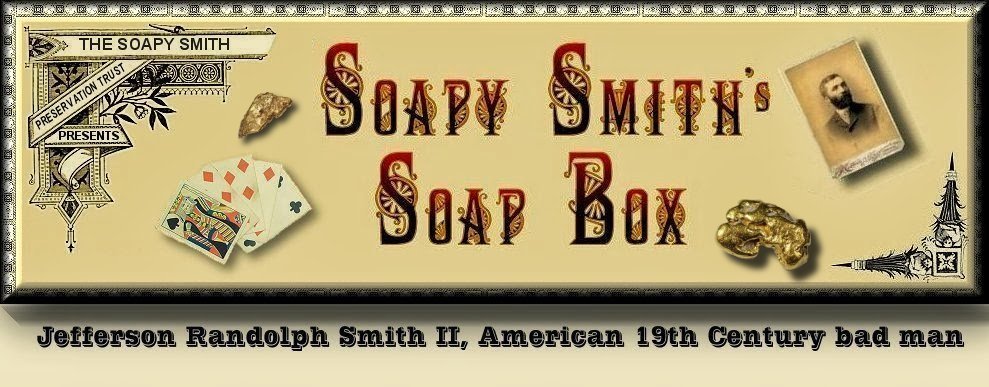uthor Cathy Spude shared some of her husbands (Bob Spude) research while the couple lived in Skagway. This first piece indicates Soapy Smith was possibly in Skagway a few earlier that originally thought. Great stuff!
Cathy writes,
Jeff:You may have already addressed this on your website somewhere, so pardon me if you already know about it. I am currently reading the articles that Sylvester Scovel wrote for the New York World in the late summer and early fall of 1897. Bob made copies years ago when he was the historian for Klondike Gold Rush NHP. Scovel wrote the following in an article published on August 27, 1897:There will be a big town here [Skaguay] all winter at least. Celebrities are coming in daily. They each think the Klondike rush to be the biggest on record. Men are here who have followed the scent of gold since the forties. Smith, known all over the West as “Soupy” [sic] Smith, has felt the pulse of the rushes to Virginia, Nevada Cripple Creek, Randsburg, Butte, Mont., and Crede [sic] with a dozen others. He is regarded as the king of prognosticators, and he says:“This thing eclipses all previous gold excitements. The best men are here, the big mine experts, the big mine owners, and the biggest gamblers. You can tell a gold strike from the number of men who gamble and what they play for. In Dawson City faro is going twenty-four hours a day with a $1,000 limit. Poker runs along without any limit and a thousand men are playing day and night. There are not more than 2,500 men digging gold in the region and that tells the story. It’s all right in the Klondike” (The New York World, August 27, 1897, p. 2).I notice in Alias Soapy, that you estimate Soapy was in Skagway by August 22. This article is datelined August 20, although it was published on August 27. Scovel had been in Skagway since late July, and would not have had a chance to interview Soapy earlier than that, so I am assuming he talked to Soapy in Skagway on or before August 20 in Skagway. This article may provide evidence that Soapy was in Skagway a little earlier than August 22.Like I said, you may have already addressed this.
CathyMy response.
Cathy, I am not familiar with this article. Good find! It could very well be that Soapy was in Skagway a couple of days, or more, than I originally published in Alias Soapy Smith. At the time, previous to 2009, I had Soapy's partners talking about that first trip to Skagway, and ship's records to go by, but perhaps strong winds prevailed? If your newspaper was datelined August 20th then I would have to agree that Soapy was in Skagway on or before August 20, 1897.Thank you for sharing it with us.
Jeff Smith
__________
ALIAS SOAPY SMITH
BOOK SALE
BOOK SALE
 |
| (Click image to enlarge) |
Soapy's first arrival in Skagway: page 435.
"... historians are forever chasing shadows, painfully aware of their inability ever to reconstruct a dead world in its completeness, however thorough or revealing their documentation. Of course they make do with other work: the business of formulating problems, of supplying explanations about cause and effect. But the certainty of such answers always remains contingent on their unavoidable remoteness from their subjects. We are doomed to be forever hailing someone who has just gone around the corner and out of earshot."
— Simon Schama, Dead Certainties [Unwarranted Speculations]
MAY 10
1773: The English Parliament passes the Tea Act which taxes all tea in the U.S. colonies.
1775: Ethan Allen and Colonel Benedict Arnold lead an attack capturing the British Fort Ticonderoga.
1840: Mormon leader Joseph Smith moves his band of followers to Illinois to escape the hostilities they had experienced in Missouri.
1865: Confederate President Jefferson Davis is captured by Union troops in Georgia.
1868: A horse arrives at Fort Leavenworth, Kansas from St. Louis, Missouri. After receiving the “US” brand it is purchased by Captain Myles Keogh for $90 and he names the horse “Comanche.” Comanche is to become the only survivor at Custer's Massacre in 1876.
1869: The Transcontinental railroad is completed when two trains of the Central Pacific and The Union Pacific Railroads meet in Promontory, Utah. A golden spike is driven into the last rail combining the rails of the eastern and western United States.
1872: Victoria Woodhull becomes the first woman nominated for the U.S. presidency.
1873: Isham Seely and Gibson Ishtanubbee murderer their hosts, a farmer by the name of "Squirrel" Funny, and his black housekeeper, who let the two killers stay the night in their home in the Chickasaw Nation. While the farmers slept they were murdered in their beds, and then their house was looted. The two were eventually captured, tried, and hung for the murder by Judge Isaac Parker on April 21, 1876.
1876: Richard Wagner’s "Centennial Inaugural March" is heard for the first time at the Centennial Exposition in Philadelphia, Pennsylvania.
1878: A murder warrant is issued for Billy the Kid in Mesilla, New Mexico Territory.
1881: $125,000 is taken in a holdup of the Canyon Diablo to Flagstaff, Arizona Territory stagecoach. A U.S. Cavalry detachment kills five suspected bandits near Veit Spring but the loot is never recovered.
1885: A gunfight in the Junction Saloon in Ashland, Kansas pitts “Mysterious Dave” Mather and his bartending brother, Josiah, against David Barnes. Barnes is killed and two bystanders are wounded. The Mather brothers are arrested and flee after posting a $3,000 bond.
1898: A vending machine law was enacted in Omaha, Nebraska. It cost $5,000 for a permit.
1908: The first Mother's Day is observed in Grafton, West Virginia.






No comments:
Post a Comment
Thank you for leaving your comment and/or question on my blog. I always read, and will answer all questions asap. Please know that they are greatly appreciated. -Jeff Smith